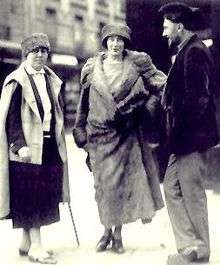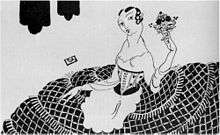Mina Loy
| Mina Loy | |
|---|---|
 Mina Loy in 1917 | |
| Born |
Mina Gertrude Löwy 27 December 1882 London, England |
| Died |
25 September 1966 (aged 83) Aspen, Colorado |
| Occupation | Writer: poet, playwright, novelist; actress, designer |
| Movement | Modernism, futurism, Dada |
Mina Loy (born Mina Gertrude Löwy; 27 December 1882 – 25 September 1966), was a British artist, writer, poet, playwright, novelist, futurist, feminist, designer of lamps, and bohemian. She was one of the last of the first generation modernists to achieve posthumous recognition. Her poetry was admired by T. S. Eliot, Ezra Pound, William Carlos Williams, Basil Bunting, Gertrude Stein, Francis Picabia and Yvor Winters, among others.
Early life
Loy was born in London. She was the daughter of a Hungarian Jewish father and an English Protestant mother. Loy's first hobby was art. She studied painting in Munich at St. John's Wood School in 1897 for two years. While in Paris, as an art student at the Académie Colarossi,[1] Loy became involved with Stephen Haweis. They moved to Paris to paint and were married there in 1903.[2] Instead of taking her husband's name, after their marriage she changed her last name from "Lowy" to "Loy."[3]
Loy's first child, Oda, was born in May 1904. By 1905 she was a frequent guest at the pre-Toklas Stein salon where—in addition to Leo and Gertrude—she met Apollinaire, Picasso, and Rousseau.[3] She became good friends with Gertrude. Oda died on her first birthday, and the marriage was already faltering by the time (Loy and Haweis) moved to Florence later in the same year.[3] Mina had two more children—Joella in 1907 and Giles in 1908. According to Gillian Hanscombe and Virginia L. Smyers, "During their ten years in Florence, both Mina and Haweis took lovers and developed their separate lives. In 1913 and 1914, though she was coping with motherhood, a soured marriage, lovers, and her own artistic aspirations, Mina found time to notice and take part in the emerging Italian Futurist movement, led by Filippo Marinetti, and to read Stein's manuscript: The Making of Americans. She became, also, at this time, a lifelong convert to Christian Science."[3]
Disillusioned with the macho elements in Futurism and its move towards Fascism, as well as desiring a divorce from her husband Stephen Haweis, Loy left her children with a nurse and moved to New York in 1916, where she began acting with the Provincetown Players. She was a key figure in the group that formed around Others magazine, which also included Man Ray, William Carlos Williams, Marcel Duchamp, and Marianne Moore. She became a Christian Scientist during this time. Loy soon became a leading member of the Greenwich Village bohemian circuit. She also met the 'poet-boxer' Arthur Cravan, a self-styled Dadaist who was a nephew of Oscar Wilde's wife, Constance Lloyd. Cravan fled to Mexico to avoid the draft; when Loy's divorce was final she followed him, and they married in Mexico City in 1918.[3] Here, they lived in poverty, and years later, Loy would write of their destitution.
When she found out that she was pregnant, she traveled on a hospital ship to Buenos Aires, "where she intended to wait for Cravan, but Cravan never appeared, nor was he ever seen again".[3] Cravan was lost at sea without trace;[4] although some mistakenly claim that his body was found later in the desert.[5] The tale of Cravan's disappearance is strongly anecdotal, as recounted by Loy's biographer, Carolyn Burke. Their daughter was born April 1919.
In a chapter of her memoir entitled "Colossus", Loy writes about her relationship with Cravan, who was introduced to her as "the prizefighter who writes poetry".[6] Irene Gammel argues that their relationship was "located at the heart of avant-garde activities [which included boxing and poetry]".[7] Loy draws on the language of boxing throughout her memoir to define the terms of her relationship with Cravan.[8]
Feminist Manifesto
In 1914, while living in an expatriate community in Florence, Italy, Loy wrote the Loy Feminist Manifesto,[9] for which she is perhaps best known today. The manifesto begins with a direct call on women:[10]
The feminist movement as at present instituted is Inadequate. Women if you want to realize yourselves—you are on the eve of a devastating psychological upheaval—all your pet illusions must be unmasked—the lies of centuries have got to go—are you prepared for the Wrench—? There is no half-measure—NO scratching on the surface of the rubbish heap of tradition, will bring about Reform, the only method is Absolute Demolition. Cease to place your confidence in economic legislation, vice-crusades & uniform education—you are glossing over Reality. Professional & commercial careers are opening up for you—Is that all you want?
A galvanising polemic against the subordinate position of women in society, the short text remained unpublished in Loy's lifetime.
Return to Europe and New York

Loy would return to Florence and her other children. However, in 1916 she moved to New York. While in New York, she worked in a lamp-shade studio, as well as acting in the Provincetown Theater. Here she returned to her old Greenwich Village life, perusing theatre or mixing with her fellow writers. She would mingle and develop friendships with the likes of Ezra Pound, Dadaist Tristan Tzara, and Jane Heap. Tzara in most accounts in 1916 was involved in founding Zurich Dada; Loy did contribute writing to Marcel Duchamp's two editions of the journal The Blind Man.
In 1923, she returned to Paris. Her first volume of poetry, Lunar Baedecker, was published this year.[11] Despite doing well in her literary career, she continued to provide for her family through the manufacture and design of lampshades, which she was creating for the shop that she opened with financial backing from Peggy Guggenheim. Loy also resumed old friendships with Djuna Barnes and Gertrude Stein. In the early 1930s, while still living in Paris, Loy began writing Insel, a künstlerroman that fictionalises her friendship with German surrealist painter Richard Oelze, a friendship begun in part because Loy was the Paris agent for her son-in-law Julien Levy's New York gallery. Loy drafted and revised Insel until 1961, when she unsuccessfully sought its publication. The novel was finally published by Black Sparrow Press in 1991, edited by Elizabeth Arnold.[12]
Later life and work
In 1936, Loy returned to New York and lived for a time with her daughter in Manhattan. She moved to the Bowery, where she found inspiration for poems and found object collages in the Bowery bums she encountered. In 1946, she became a naturalised citizen of the United States. Her second and last book, Lunar Baedeker & Time Tables, appeared in 1958. She exhibited her found object art constructions in New York in 1951 and at the Bodley Gallery in 1959. In 1953, Loy moved to Aspen, Colorado, where her daughters Joella and Jemima were already living; Joella, who had been married to the art dealer of Surrealism in New York, Julien Levy, next married the Bauhaus artist and typographer Herbert Bayer. In Colorado, Mina Loy continued to write and work on her junk collages until her death at the age of 83, from pneumonia, in Aspen.
Writing

Loy's poetry was published in several magazines before being published in book form. The magazines that she was featured in include Camera Work, Trend and Rogue. Loy had two volumes of her poetry published in her lifetime: The Lunar Baedeker (1923) and The Lunar Baedeker & time-tables (1958). Posthumously, two updated volumes of her poetry were released, The Last Lunar Baedeker (1985) and The Lost Lunar Baedeker (1997), both edited by Roger L. Conover. Songs to Joannes is in The Lost Lunar Baedeker.[13]
She also wrote two screenplays: The Sacred Prostitute (1914)[14] and Parturition (1914).[15]
Her only novel, Insel, was published posthumously in 1991. It is about the relationship between a German artist, Insel, and an art dealer, Mrs. Jones. Some critics have suggested that the novel is based on Loy's relationship with Richard Oelze. However, Sandeep Parmar has said that it is actually about Loy's relationship with her creative self.[16]
Children
Loy had four children; her children by Haweis were Oda Janet Haweis (1903–1904), Joella Synara Haweis Levy Bayer (1907–2004) and John Giles Stephen Musgrove Haweis (1909–1923). Her only child with Cravan was Jemima Fabienne Cravan Benedict (1919–1997).[17]
Notes
- ↑ Burke, Carolyn (1997). Becoming Modern: The Life of Mina Loy. University of California Press (Reprint edition). p. 75–76. ISBN 978-0520210899.
- ↑ "Stephen Haweis Papers". www.columbia.edu. Retrieved 2017-04-01.
- 1 2 3 4 5 6 Hanscombe, Gillian; Smyers, Virginia L. (1987), Writing for Their Lives: The Modernist Women, 1910–1940, Boston: Northeastern University Press, pp. 112–128, retrieved 23 March 2017
- ↑ Parmar, Sandeep, Mina Loy’s ‘Colossus’ and the Myth of Arthur Cravan, Jacket 34, October 2007
- ↑ Rainey, Lawrence (2005). Modernism: An Anthology. Malden, MA, United States of America: Blackwell Publishing. p. 417. ISBN 978-0-631-20448-0.
- ↑ Loy cited in Gammel, Irene (2012), "Lacing up the Gloves: Women, Boxing and Modernity". Cultural and Social History 9.3, p. 379.
- ↑ Gammel 2012, p. 380
- ↑ Gammel 2012, pp. 379–81
- ↑ Feminist Manifesto
- ↑ https://oncomouse.github.io/loy/feminist.html
- ↑ "Britannica Academic". academic.eb.com. Retrieved 2017-04-01.
- ↑ Arnold, Elizabeth (1991). "Afterword" Insel. By Mina Loy. Santa Rosa: Black Sparrow Press. ISBN 978-0-87685-853-0
- ↑ Lyon, Janet; Majerus, Elizabeth. "On "Love Songs" / "Songs to Joannes"". Modern American Poetry. Retrieved 31 October 2016.
- ↑ Foundation, Poetry. "Mina Loy, Canopy Canopy Canopy, and The Sacred Prostitute". Harriet: The Blog. Archived from the original on 1 April 2017. Retrieved 1 April 2017.
- ↑ "Poetry Daily's Poet's Pick April 28, 2015". poems.com. Retrieved 2017-04-01.
- ↑ Parmar, Sandeep (2013). The Reading Mina Loy's Autobiographies: Myth of the Modern Woman. London: A&C Black. ISBN 9781441176400.
- ↑ Rainey, Lawrence (2005). Modernism: An Anthology. Malden, MA: Wiley-Blackwell. p. 417. ISBN 0631204490.
References
- Burke, Carolyn. Becoming Modern: The Life of Mina Loy. New York: Farrar, Straus and Giroux, 1996.
- Gammel, Irene. "Lacing up the Gloves: Women, Boxing and Modernity." Cultural and Social History 9.3 (2012): 369–390.
- Kouidis, Virginia. Mina Loy: American Modernist Poet. Baton Rouge: Louisiana State UP, 1980.
- Kuenzli, Rudolf. Dada (Themes and Movements). Phaidon Press, 2006. [Includes poetry by Mina and her relationship to several artists.]
- Loy, Mina. The Lost Lunar Baedeker. Selected and ed. Roger Conover. 1996.
- –––, and Julien Levy. Constructions, 14–25 April 1959. New York: Bodley Gallery, 1959. OCLC 11251843. [Solo exhibition catalogue with commentary.]
- Lusty, Natalya. "'Sexing the Manifesto: Mina Loy, Feminism and Futurism'", Women: A Cultural Review, 19:3, pp. 245–260. 2008.
- Prescott, Tara. 'A Lyric Elixir': The Search for Identity in the Works of Mina Loy, Claremont Colleges, 2010.
- Shreiber, Maeera, and Keith Tuma, eds. Mina Loy: Woman and Poet. National Poetry Foundation, 1998. [Collection of essays on Mina Loy's poetry, with 1965 interview and bibliography.]
- Parisi, Joseph. 100 Essential Modern Poems by Women (The greatest poems written in English by women over the past 150 years, memorable masterpieces to read, reread, and enjoy). Chicago: Ivan R. Dee, 2008.
External links
- Vorticist Portraiture in Mina Loy’s Anglo-Mongrels and the Rose in Cordite Poetry Review
- Mina Loy at Modern American Poetry
- Mina Loy at Modernism: American Salons (Case Western) – photographs, works, bibliography, and links
- Mina Loy at the Modernist Journals Project – examples of visual art
- Mina Loy and Djuna Barnes and Mina Loy: Drafts of "Nancy Cunard", Intimate Circles: American Women in the Arts, Beinecke Rare Book and Manuscript Library, Yale University, accessed 30 January 2008.
- Mina Loy, "The Sacred Prostitute"
- En breve luz: Arthur Cravan y Mina Loy (in Spanish). Función Lenguaje.
- Mina Loy’s ‘Colossus’ and the Myth of Arthur Cravan by Sandeep Parmar, Jacket 34, October 2007